Welcome to the latest edition of Looks from Books, which aims to prove that you can look smart, while still being book-smart, too. Fashion inspiration can be found between the pages of your favorite stories, on well-designed book covers, and in your favorite characters… if you read closely enough.
Everyone’s getting into the Halloween spirit, especially us here at College Fashion! With ideas all around, from how to build a look that’s geek and chic but still unique, or where to shop for quality costumes on a college budget, I’ve been contemplating on how to celebrate the dark and spooky without going too literal… so I turned to one of my all-time horror favorites, Frankenstein, for a jolt of inspiration!
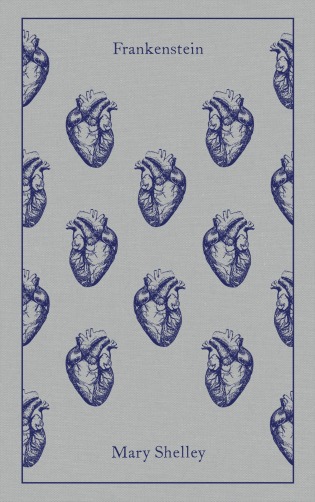
Frankenstein book cover via Amazon
Table of Contents
Inside Cover
Frankenstein; or The Modern Prometheus, was written by then-nineteen-year-old Mary Shelley in 1816, and was published in1818.
The classic horror novel details the story of brilliant young scientist Victor Frankenstein and his ambitious undertaking of the creation of life, via the highly unorthodox medium of re-animating dead human parts. However, the monstrous end result of his experiments proves to be too horrifying for him to live with and the creature he creates soon begins to wreak havoc on his life.
The novel created quite the stir upon its debut, and not just because its young author – daughter of notable feminist Mary Wollstonecraft and novelist William Godwin – was carrying on a not-so-secret affair with notable (and married) poet Percy Blyce Shelley when it was originally written.
The elements of the novel – including the practice of galvanism – that took part in the monster’s construction were widely considered as bordering on the occult, and surprised critics when exposed to be the imaginings of a young woman. Despite this, or maybe even because of it, the novel was a best-selling success immediately upon its literary premiere.
A Fashionable Literacy
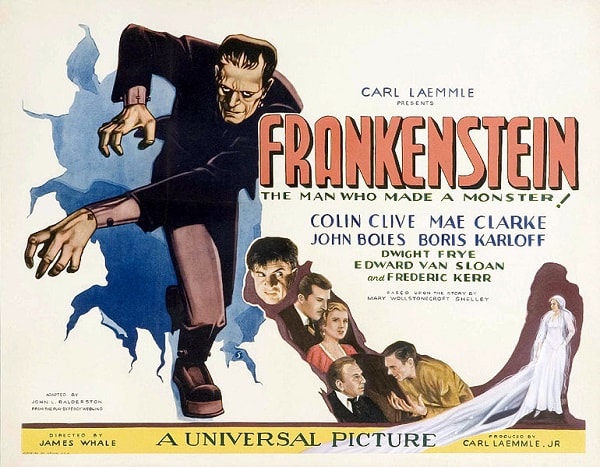
Frankenstein movie poster via Wikimedia Commons
There have been numerous adaptations of Frankenstein in the media throughout the years. In fact, some adaptations were around back when Mary Shelley was still alive to see them: she attended a theatrical work, dubbed Presumption; or the Fate of Frankenstein, by Richard Brinsley Peake, in 1823.
Just three short years later, Henry M. Milner, a 19th century playwright, produced his most historically notable work, Frankenstein; or The Man and the Monster. In this retelling of the story, Milner added much to the original script, including the now-iconic line, “It lives!”
Other now-iconic associations with the monster, brought about through its various iterations – particularly the string of movies made by Universal in the 1930s – don’t align so well with the actual story. For instance, in the novel, Frankenstein’s monster was originally intended to be handsome, as an “ideal,” because Victor was attempting to create the perfect man. It was only his horrifying nature – a creation built from the dead – that so twisted these looks to be frightening. In other words, no flat top, no green skin, and no neck bolts.
Because of the necessity of the genre of horror, the subtle fear of not primarily the monster, but what he symbolized, caused this exaggeration for the land of the cinema. Similarly, the fashions of popular adaptations are also exaggerated deviations from the original story.
How to Add Victor to Your Wardrobe
By integrating key elements from the novel into your own look, you, too, can pay homage to the harrowing, horrifying tale and its legacy as one of the greatest monster stories of all time!
A Natural Romantic
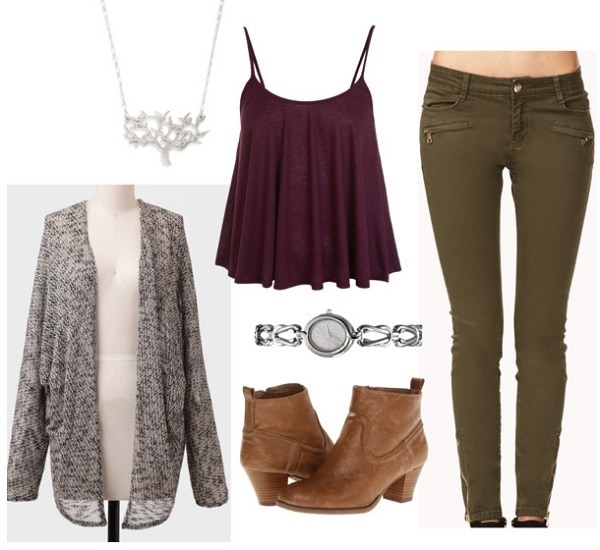
Product Information: Necklace – Modcloth, Cardigan – ShopRuche, Top – Miss Selfridge, Watch – Target, Boots – Zappos, Jeans – Forever 21.
The book’s genre, beyond its status as an iconic title of classic horror, is technically Gothic Romanticism, a genre which, during the early 19th century, was only just starting to gain traction. (To put it in context, Frankenstein was written around the same time as Pride and Prejudice, but Jane Eyre wouldn’t come out until 1847, about a generation later.)
You can interpret this literary movement into your own style, with a more balanced approach than just black and lace. Emphasize the dynamics, the ties between nature and mood, and the distinct unrestrained emotional experience and spiritual renewal found within the genres. Pay particular focus to the Arctic – the backdrop for the ultimate struggle in the novel – as the symbol for emotional waste, barren of life.
Channel the romantic side of things in earthy tones and rough fabrics with the leather booties and olive jeans, and bring dynamics into play with the swing top and duster cardigan. For the Gothic side, the frigid chill of the Arctic mixes with with the genre’s ties to nature in a silver tree necklace, and time ticks away on a cold, silver watch.
What’s In a Name
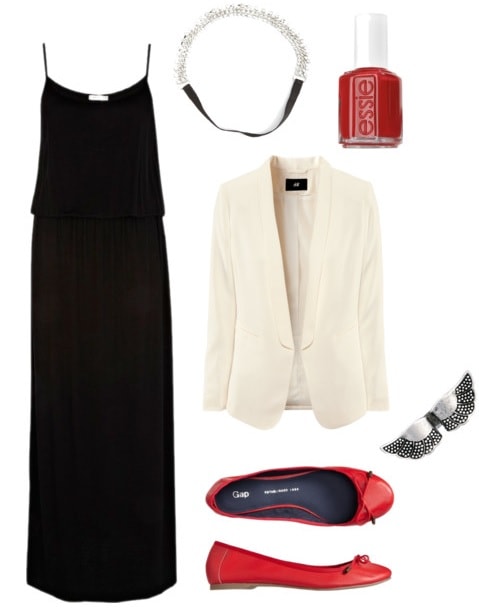
Product Information: Dress – River Island, Headband – Charlotte Russe, Nail Polish – Essie, Blazer – H&M, Ring – Asos, Flats – Gap.
One of the greatest enduring debates centered around the book is the question of what to call the creature central to the novel, since his common misnomer, Frankenstein, is the name of the maker, not the monster itself.
The various connotations of the monster’s respective names – like the religious nature of “Adam” and “fallen angel” – have a certain “lightness”, which is contrasted with the dark, shapelessness of his other names, like “monster,” “daemon,” “creature.” He represents a mix of beauty, life, science, and knowledge, contrasted with the darkness of secrets, ambition, and hatred.
Channel this mix of the light side of the monster’s name in an angelic white blazer, silver halo-esque headband, and a wing ring. The dark side is represented in a flowing black maxi, flaming red shoes, and fiery nails.
…But How You Say It
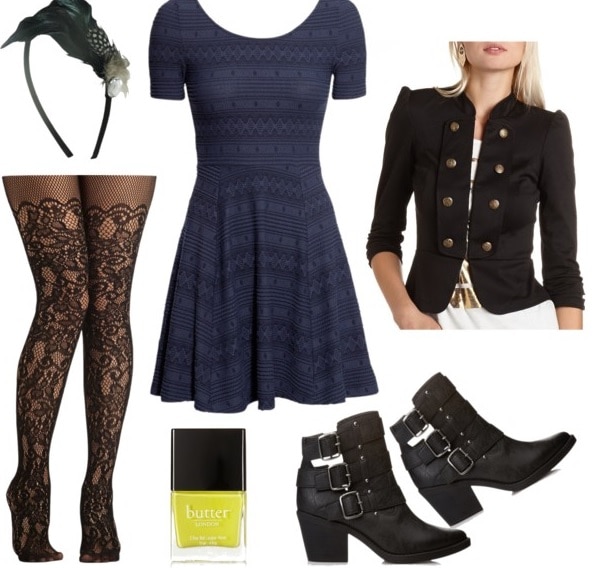
Product Information: Headband – Target, Tights – Modcloth, Dress – H&M, Nail Polish – Butter London, Jacket – Charlotte Russe, Boots – Forever 21.
It can’t be overlooked that Frankenstein served as an introductory work done by a very young and competitive author who was only twenty-one at the time of its widespread success. Because of her ambition and youthful zeal – as well as the fact that the original story was contrived as a means of winning a storytelling contest among her circle of friends while on vacation – the novel is constructed from some dense, elaborate prose, and it is one of the most obvious and distinct literary elements present in the story.
Channel this flowery and heavy diction, by constructing an outfit based around intricate patterns, exaggerated numbers, and unique statement items. Lace tights and a patterned dress draw in your attention, while buckled booties and a military jacket amp up the number count. A luxe feather headband elevates the look, while a jolt of electric yellow brings the whole outfit to life.
What Do You Think?
Have you ever read Frankenstein, or similarly terrifying tales? Have you ever had it assigned for class, or lecture? What did you think of the novel, and the elements at play? Have you seen any of the movies? What do you think of the outfits and styling tips? Let me know, in the comments below!

Great feature! I love how creatively you adapted the genre and themes of the book into outfits…keep it up!